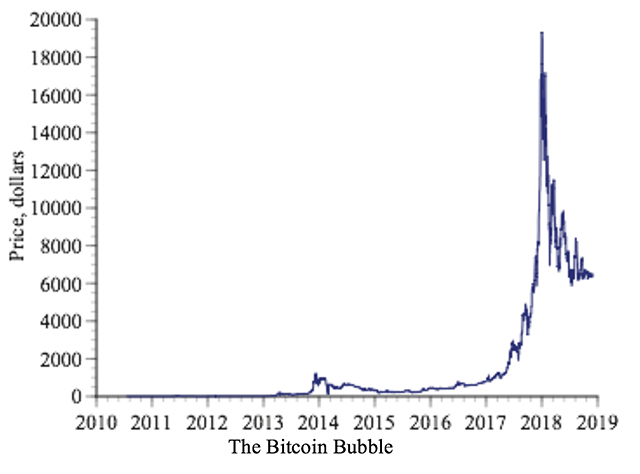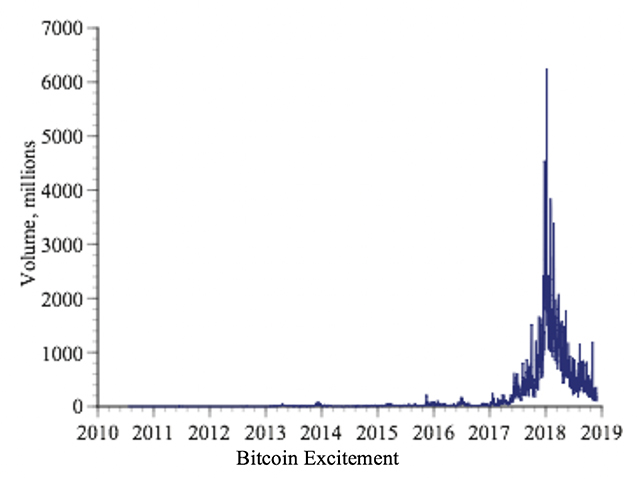Cryptocurrency
Opinion: Bitcoin still fooling buyers into believing those 200%-plus gains are coming back

Gettyimage
Speculative investments that do not generate cash are prone to bubbles and crashes
Investors at times are gripped by what, in retrospect, seems to have been mass hysteria. The price of something climbs higher and higher, with nothing to justify the rising price except investors’ hope that it will go higher still. Then, this speculative bubble pops, buyers vanish, and the price collapses. With hindsight, it is hard to see how people could have been so foolish. Yet, at the time of the bubble, it seemed foolish to sit on the sidelines while others became rich.
Which brings us to bitcoin BTCUSD, +0.46% Bitcoin does not generate cash or pay dividends, but bitcoin prices can rise as long as greater fools think that they can sell at higher prices than they paid.
Look at the charts, below. Figures 1 and 2 show the bitcoin daily price and volume of bitcoin trading since 2010. There was runup in bitcoin’s price and volume in 2017, culminating in nearly simultaneous peaks in December 2017 (a peak price of $19,345 on December 16 and peak volume of 5.2 billion on December 22), followed by sharp drops in price and volume after the peaks. These strong co-movements in price and volume are consistent with the view that both the runup and the decline were caused by investor speculation.
Nonetheless, a recent research paper by Yale University economics professor Aleh Tsyvinski and a graduate student, Yukun Liu, endorses bitcoin as an investment worth owning. Is their argument compelling?


They looked at data for January 1, 2011, through May 31, 2018, a period when bitcoin’s price increased to $7,530.55 from 30 cent — an annualized return of 292%. It is frankly delusional to treat this price explosion as a normal return that can be analyzed the way one would analyze the historical returns from bonds, stocks, real estate, and other investments. It is even more unrealistic to think that this bubbly return is what investors can expect going forward, especially since bitcoin’s price plummeted more than 60% in less than six months, from $19,345 on December 16, 2017, to $7,530 on May 31, 2018, the end-point of the data Liu and Tsyvinski analyzed.
Price momentum and internet fever are exactly what we expect in a speculative bubble, not reliables guide for making money.
Yet, the researchers treated bitcoin as an investment, like stocks and bonds. Not surprisingly, they found evidence of momentum in bitcoin prices. Figure 1, “The Bitcoin Bubble,” shows that when the price increased, it tended to keep increasing, and when the price fell, it tended to keep falling. Not surprisingly, the researchers also found that bitcoin prices tended to increase after a surge in Google searches for the word “bitcoin,” and Twitter posts using the word “bitcoin,” and, conversely, that Google searches for bitcoin increased after bitcoin prices went up. Price momentum and internet fever are exactly what we expect in a speculative bubble, not reliables guide for making money.
Tsyvinski and Liu acknowledge that, unlike stocks, bitcoin doesn’t generate cash or pay dividends, so they used what they call a “similar metric” — in this case the number of Bitcoin Wallet users, and calculated a “proxy” dividend-price ratio by comparing bitcoin prices to the number of Bitcoin Wallet users. The number of Bitcoin Wallet users is not a substitute for cash dividends paid to stockholders. This farfetched proxy is reminiscent of the useless metrics (like website visitors) that wishful investors conjured up during the dot-com bubble to justify ever higher stock prices.
Tsyvinski and Liu also calculated hundreds of correlations between bitcoin prices and other variables and reported that bitcoin returns are positively correlated with stock returns in the consumer goods and health care industries and negatively correlated with stocks returns in the fabricated products and metal mining industries.
We have no idea what to make of this; nor do they: “We don’t give explanations,” the researchers report. “We just document this behavior.”
In other words, a plethora of calculations do not refute the facts that (a) legitimate investments generate cash that rewards investors; and (b) speculative investments that do not generate cash are prone to bubbles and crashes.
Despite these bubbly signs, Tsyvinski and Liu recommend that:
“If you as an investor believe that Bitcoin will perform as well as it has historically, then you should hold 6% of your portfolio in Bitcoin. If you believe that it will do half as well, you should hold 4%. In all other circumstances, if you think it will do much worse, then you should still hold 1%.”
The 6% portfolio recommendation is based on the assumption that bitcoin’s future return will be 200% higher than the return on other assets; the 3% recommendation on a future bitcoin return that is 100% higher than on other assets. “All other circumstances” is the worst-possible case they consider, that bitcoin will beat other assets only by 30% a year.
The researchers do not consider the preposterous implications of these implausible assumptions. On May 31, 2018, the last day used in their analysis, bitcoin’s price was $7,530.55, If, starting at a price of $7,530.55, the price were to increase by 100% a year, the price would be nearly $8 million 10 years from now. With a 200% annual increase, bitcoin’s price would be $445 million. These numbers don’t pass the straight-face test. I don’t know what the price of bitcoin will be in 2028, but I am confident that it will be a lot closer zero than $445 million.
Source – marketwatch.com
-

 Cryptocurrency3 weeks ago
Cryptocurrency3 weeks ago10 High-Potential Crypto Airdrops: December 2024 Edition
-

 Cryptocurrency3 weeks ago
Cryptocurrency3 weeks agoTop 10 Sui Meme Coins to Watch in 2024: A High-Risk, High-Reward Opportunity
-

 Cryptocurrency3 weeks ago
Cryptocurrency3 weeks agoCrypto Whales are Buying This Gem at $0.125: Why You Should Too
-

 Cryptocurrency1 week ago
Cryptocurrency1 week agoTop 4 Altcoins to Consider Holding Before the 2025 Bull Run
-

 How to3 weeks ago
How to3 weeks agoHow to Spot PAN Card Misuse: A Comprehensive Guide
-

 Money1 week ago
Money1 week ago6 High-Return Investment Options to Consider
-

 How to3 weeks ago
How to3 weeks agoGet Your PAN 2.0: How to Reprint Your PAN Card with a QR Code
-

 Money1 day ago
Money1 day agoIndia’s Stock Market Trading Holidays 2025








